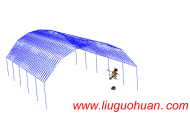地震多点反应谱模型存在缺陷的改进与验证作者: 柳国环,练继建,国巍,耿辰,田利 |
||||||
下载次数:
次 更多论文下载...
PDF格式(左键浏览,右键另存):
2014 年12月
摘要:本文全面考究并揭示了地震多点反应谱模型误差的偶然性和必然性,涉及推导过程与计算结果两个层面。首先,扼要论述当前多点反应谱研究进展,详列给出加速度、位移以及位移-速度三种时域模型的本质区别,推导出基于位移和位移-速度输入模型的多点反应谱。然后,阐述基于位移-速度输入模型所推导的多点反应谱模型具有严格逻辑性,明确指出基于位移输入模型所导出反应谱的缺陷及其逻辑必然性,揭示基于加速度模型导出的多点反应谱计算结果有效的偶然性、必然性及其适用范围。最后,给出数值算例予以验证。分析表明:(1)基于位移-速度所导出的多点反应谱理论严格;(2)基于位移输入模型所导出的多点反应谱会导致底部单元内力不收敛,计算结果不合理;(3)基于加速度输入模型导出的多点反应谱结果虽然有效,但适用于经典阻尼体系,而且在推导过程中所忽略项在理论上具有误差相互抵消的特点。 关键词:地震地面运动;多点反应谱;加速度输入模型;位移-输入模型;位移-速度输入模型;经典阻尼 中图分类号:P315.9;U442 文献标识码:A 文章编号: Abstract: The Multiple Support Response Spectrum (MSRS) model for evaluating responses of structure under multi-support seismic excitations is re-recognized from two aspects involved in deducing process and calculation results. Firstly, the state-of-the-art review on MSRS is reviewed briefly. The difference of three different input types of model (acceleration, displacement and displacement-velocity model) is analyzed in essence. The MSRS theory formula based on displacement and displacement-velocity model are induced and given. Then, this paper expounds that it is logical and strict for MSRS formula to be deduced from displacement-velocity model instead of the displacement model. Then, the irrationality and unconvergency of the responses calculated from the D-MSRS(Displacement-Multiple Support Response Spectrum) model, derived from the current displacement input model is pointed out explicitly. While, it addresses that the accidence in deducing processing, and necessity in calculation results of MSRS deduced from acceleration model. Finally, the deriving processing and numerical results show that (1) the DV-MSRS(Displacement Velocity-Multiple Support Response Spectrum) is strict and matter-of-course in logically. (2) the D-MSRS will induce the unreasonable and unconvergent internal force of bottom element. (3) the reasonability of A-MSRS(Acceleration-Multiple Support Response Spectrum)derives from the two negligible terms can be counteract,but is suitable to classic damping system. Key words:seismic ground motion; multi-support response spectrum (MSRS); acceleration input model; displacement input model; displacement-velocity input model; classical damping 引言
地震地面运动往往具有不均匀性,地震动的多点输入(差动输入)现象会导致结构反应与一致输入情形存在差别,这对于大跨结构而言差别更为明显。当前,地震动多点输入下的结构反应分析已成为抗震工程界研究热点之一,位移输入计算模型备受青睐。之所以如此,原因包括:(1)在时域内,位移输入模型不仅适用于一致激励还适用于多点激励,既适用于结构线性也适用于其非线性分析,直接得到的计算结果是绝对量值,该模型被认为是当前求解结构地震反应的具有普适性和有效性的计算模型。(2)在频域内,根据随机振动理论可以推导出MSRS(Multi-support Response Spectrum)法理论表达式,与时程分析方法相比,该方法计算快、简单实用,可方便用于工程结构设计。
国内外学者在MSRS法方面作了诸多工作。Asfura等[针对地震激励下的二次结构在多支撑输入下进行了反应谱分析。Yamamura等[2]将结构中相距较近支承点归为一组,假定各组内支承点位置的地面运动完全相干而反应采用CQC(Complete Quadratic Combination)法加以组合,假定各组之间地面运动互不相关而反应采用SRSS(Square Root of Sum of Squares)法进行组合。Berrah等[利用修正系数对反应谱值进行修正来考虑地震动多点激励的空间变化效应,并利用一致激励情形时组合方法求解结构最大响应。Berrah等[4]在后续工作中对一致激励反应谱振型组合方法中相关系数进行了修正,而仍未考虑拟静力与动力响应的耦合项。Kiureghian等人在经典文献[5]中采用随机振动理论推导出了具有较严格意义的MSRS法,理论推导过程严密、思路清晰,考虑了行波效应、部分相干和局部场地效应影响,还考虑了地面运动的相关性以及各振型之间的相关性。Loh等人针对MSRS计算量大的缺点,给出了积分系数求解简化的计算方法。Kahan等[基于MSRS法,探讨了在地面运动空间变化程度较小时MSRS法的简化表达形式,但其应用范围受到局限。我国学者王君杰推导出一般阻尼结构体系在多维多点地震动作用下的结构响应的MSRS法。李杰等人简化了组合公式中的谱参数和相关系数的计算方法,提高了计算效率。刘先明等人对拟静力反应项与动力反应项进行了研究并予以简化,从而减少了计算量。孙建梅等人基于虚拟激励法提出一种形式简单,概念明确的MSRS法,并针对公式中耦合系数需要数值积分求解而导致计算量大的缺点,提出了快速计算方法。苏亮[13]提出将结构绝对反应直接振型分解,而不再将分解为拟静力反应和动力反应两部分,该法简化了分析计算。关于MSRS法的研究成果可谓成绩斐然,难全列举。但是不难发现,目前的MSRS法是基于位移-速度输入模型基础上忽略两项阻尼的加速度输入模型而推导出的,包括由Kiureghian提出的目前相对最为严密的MSRS法。然而,值得一提的是,Wilson教授在其著作中提到:采用数学模型分析可能得到与实际物理模型行为有较大差异的计算结果,并作了相关说明,但是没有得到应有的关注与重视。应该说明,这里所谈及到的数学模型即为加速度输入模型。近些年来位移输入模型被广泛采用,作者也强调了位移输入模型的优势与缺陷,陆续作了系统性相关介绍:基于文献[14]提示,作者在后续工作中更加全面详细地分析了位移输入模型存在的容易但不容忽视的问题,并提出了理论严格的附加无质量刚性元(AMCE)实效对策;然后,为了能够便于结构工程师解决实际工程问题,又进一步提出了一种新方法-无质量刚性元法,该方法具有实用意义,已经应用于一实际桥梁工程计算。文献[17]和[18]处理问题方法的巧妙性在于没有引入地面运动的速度项,仍采用位移输入模型本身解决位移输入模型中存在的不可忽视的问题。这样处理的优点是:工程师可以采用该方法直接利用已纳入位移输入模型的有限元软件(例如:以Wilson 教授为顾问的美国CSI开发的SAP2000)得到可靠的时域计算结果,而没有必要对源程序加以改进。进而,将该方法推广至基岩输入的土-结构共同作用计算模型。相比之下,位移-速度模型保留了上述的速度项,相关内容在文献[16]、[17]与[20]中有谈及到。考虑结构非比例阻尼的影响,作者研究并指出了隔震和安装阻尼器等多种非比例阻尼所导致的位移和加速度模型的计算误差情况,并给出了有益的使用指导建议和计算模型修正方法,以作者之前研究组成了较为系统的多点地震动计算模型研究成果。 计算结果的有效性直接取决于数学模型如何恰当地表示实际物理体系的运动特性。不失一般性,任何结构分析中的数学模型理论公式表达式是否合理有效应该成为首要关心的问题,加速度输入模型与位移输入模型也不例外。因此,对于目前基于加速度输入模型导出的MSRS表达式,以及由位移输入模型导出的多点反应谱公式重新认识实有必要。与位移-速度模型相比,加速度输入模型忽略了两项阻尼,位移输入模型忽略了一项阻尼,那么就势必会导致基于该模型得到的MSRS表达式必然性地有所不同,这一点理应毋庸置疑,这或许就不得不让感兴趣者自然地多了一个关心:应从推导过程角度和计算结果层面对MSRS重新作进一步分析和认识。鉴此,本文指出并揭示了当前基于“加速度输入模型”所导出的MSRS模型的“偶然性”和“必然性”,而不止步于只是在推导过程中的简单的与速度项相关的阻尼“忽略”,指出并强调了基于位移输入模型导出MSRS的不合理及其逻辑必然性,阐述了有必要基于“位移-速度输入模型”导出MSRS的严格逻辑性和必要性,并给出理论公式。最后,结合算例进行了算例验证与说明。 结论
本文对多点反应谱模型作了几项工作,简要总结如下:
(1)揭示A-MSRS计算结果有效的偶然性和必然性,使得A-MSRS得以客观应有的认识,进而指出了在理论上严格的适用范围─经典阻尼结构体系。(2)指出D-MSRS所导致问题(底部单元内力随单元精细划分而不收敛)的逻辑必然性,阐述其根本原因,进而通过算例验证了这一事实。 (3)推导给出了DV-MSRS,并通过算例验证了计算结果的有效性和稳定性。 应该指出,对于非经典阻尼结构体系,DV-MSRS与A-MSRS之间的差别及其不容忽视性将在后续文章中详细给出。 参考文献(References): [1]Alejandro Asfura, Armen Der Kiureghian. Floor response spectrum method for seismic analysis of multiply supported secondary systems[J]. Earthquake Engineering & Structural Dynamics, 1985,14(2): 245-265. [2]Yamamura N, Tanaka H. Response analysis of flexible MDF systems for multiple-support seismic excitations[J]. Earthquake Engineering &Structural Dynamics, 1990, 19: 345-357. [3]Berrah M, Kausel E. Response spectrum analysis of structures subjected to spatially varying motions[J]. Earthquake Engineering & Structural Dynamics, 1992, 21(6): 461-470. [4]Berrah M, Kausel E. A modal combination rule for spatially varying seismic motions[J]. Earthquake Engineering &Structural Dynamics, 1993, 22(9): 791-800. [5]Armen Der Kiureghian, Ansgar Neuenhofer. Response spectrum method for multi-support seismic excitations[J]. Earthquake Engineering & Structural Dynamics, 1992,21(8): 713-740. [6]Chin-Hsiung Loh and Bao-Ding Ku. An efficient analysis of structural response for multiple-support seismic excitations[J]. Engineering Structures, 1995,17(1): 15-26. [7]Kahan M., Gibert R. Influence of seismic waves spatial variability on bridges: a sensitivity analysis. [J]. Earthquake Engineering & Structural Dynamics, 1996,25(8): 795-814. [8]王君杰. 多点多维地震动随机模型及结构的反应谱分析[D]. 哈尔滨:国家地震局工程力学研究所,1992. Wang Junjie. Stochastic model of multi-component multi-support seismic motion and structural response spectrum analysis[D].Harbin: Institute of Engineering Mechanics of State Seismological Bureau,1992. [9]李杰,李建华. 多点地震激励下结构随机地震反应分析的反应谱法[J].地震工程与工程振动,2004,24(3):21-29. Li Jie, Li Jianhua. A response spectrum method for random vibration analysis of structures under multi-support excitation[J]. Earthquake Engineering and Engineering Vibration, 2004,24(3):21-29. [10]刘先明,叶继红,李爱群. 多点输入反应谱法的理论研究.土木工程学报,2005,38(3):17-22. Liu Xianming, Ye Jihong, Li Aiqun. Research of multi-support response spectrum method[J]. China Civil Engineering Journal, 2005,38(3):17-22. [11]孙建梅,叶继红,程文穰. 多点输入下大跨空间网格结构的可靠度分析[J].应用力学学报, 2005, 22(4):560-566. [12]叶继红,孙建梅. 多点激励反应谱法的理论研究[J]. 应用力学学报,2007,24(1). 47-53. Ye Jihong ,Sun Jianmei. Response spectrum method for multi-support seismic excitation. Chinese Journal of applied mechanics, 2007,24(1). 47-53. [13]苏亮. 大跨空间结构的多点反应谱法和多点地震反应性状的研究(博士后研究工作报告).浙江:浙江大学. [14]Edward L. Wilson. Three-dimensional static and dynamic analysis of structures: A physical approach with emphasis on earthquake engineering[M]. California: Computers and Structures, Inc. 2004. [15]柳国环,李宏男,林海.结构地震响应计算模型的比较与分析[J].工程力学, 2009,26(2):10–15. Liu Guohuan, Li Hongnan, Lin Hai. Model comparision and analysis for structural seismic response[J]. Engineering Mechanics. 2009,26(2):10–15 (in chinese). [16]柳国环,李宏男,国巍.求解结构地震响应位移输入模型存在的问题及其AMCE实效对策[J]. 计算力学学报,2009,26(6):862–869. Liu Guohuan , Li Hongnan, Guo wei. Existing problem of displacement input model for calculating structural responses under earthquake ground motion and its an actual effective solution method called AMCE[J]. Chinese Journal. of Computational Mechanics2009,26(6):862–869.(in Chinese). [17]柳国环,李宏男,国巍等.求解结构地震响应位移输入模型中存在问题的一种新解决方法[J]. 工程力学, 2010,27(9): 55-62. Liu Guohuan , Li Hong nan , Guo Wei, Tian-Li . A new method for solving existing problem of current displacementinput model for calculating structural seismic responses[J]. Engineering Mechanics, 2010, 27(9): 55–62.(in chinese). [18]柳国环,李宏男,田利.九江长江大桥在多点多维地震激励下的反应分析[J]. 振动与冲击, 2009,28(9):204-209. Liu Guohuan , Li Hong nan, Tian Li . Response analysis of JIUJIANG Yangtze River highway bridge under spatially variable earthquake ground motions[J]. Journal of Vibration and Shock, 2009,28(9): 204-209(in chinese). [19]柳国环,陆新征.基岩地震谱与地震动位移输入的土–结构相互作用(SSI)计算模型改进[J]. 岩石力学与工程学报, 2012, 29(4): 2011, 30(5): 884-892. Liu Guohuan, Lu Xinzheng. Spectra of bedrock earthquake motion and improvement of soil-structure interaction (SSI) calculation model for seismic displacement inputting[J], Chinese Journal of Rock Mechanics and Engineering, 2011, 30(5): 884-892(in chinese). [20]柳国环,陆新征,国巍,等. 主跨300米级独塔斜拉桥考虑地震动多点激励与材料应变率效应的弹塑性分析[J]. 计算力学学报,(录用待发表). Liu Guohuan, Lu Xinzheng, Guo Wei. Study of steel strain-rate and multiple earthquake motions effect on elasto-plasticity responses of 300m span single tower cable-stayed bridge[J]. Chinese Journal.of Computational Mechanics,(accepted). [21]国巍, 余志武, 柳国环, 田利. 大跨隔震结构多点地震计算模型的几点注记[J], 哈尔滨工业大学学报, 2013, 10. (录用待发表). Guo Wei, Yu Zhiwu, Liu Guohuan, Tian Li. Notes about calculation models for seismic analysis of long-span isolated structure under multi-point earthquake excitations[J]. Journal of Harbin Institute of Technology, 2013, 8. (in press). [22]国巍, 余志武, 国振. 多点激励下大跨隔震结构分析模型的阻尼与误差[J]. 华中科技大学学报(自然科学版), 2012, 40(9): 101-105. Guo Wei, Yu Zhiwu, Guo Zhen. Analysis model for long-span isolated structure subjected to multi-support earthquake excitations[J]. Journal of Huazhong University of Science and Technology (Nature Science), 2012, 40(9): 101-105. [23].Guo Wei, Yu Zhiwu, Liu Guohuan, Guo Zhen. Possible existing seismic analysis errors of long span structures and bridges while utilizing multi-point earthquake calculation models [J], Bulletin of Earthquake Engineering, 2013, 5, DOI 10.1007/s10518-013- 9462-3. (in press). [24]. Annil K. Chopra著. 谢礼立,吕大刚译. 结构动力学理论及其在地震工程中的应用[M].(第2版)北京:科学出版社, 2010,11. Annil K. Chopra. Xie Lili, Lv Dagang. Dynamics of structures theory and applications to earthquake engineering[M]. (second edition) Beijing: Higher Education Press, 2010,11(in chinese). [25].潘晓东. 非平稳随机地震下堤坝非线性有效应力动力响应可靠度分析[D]. 杭州:浙江大学,2004. Pan Xiaodong. Nonlinear probabilistic dynamic response analysis of effective stress of earth dams under non-stationary seismic loadings[D]. Zhejiang University, 2004 (in Chinese). [26].Hao Hong, Oliveira C.S, J. Penzien. Multiple-station ground motion processing and simulation based on smart-1 array data[J] Nuclear Engineering and Design,1989, 111(3): 293-310. |
||||||
| welcome to www.liuguohuan.net |
| 天津大学 建筑工程学院 ; 天津大学 前沿技术研究院; 国家重点实验室-水利工程仿真与安全 |







